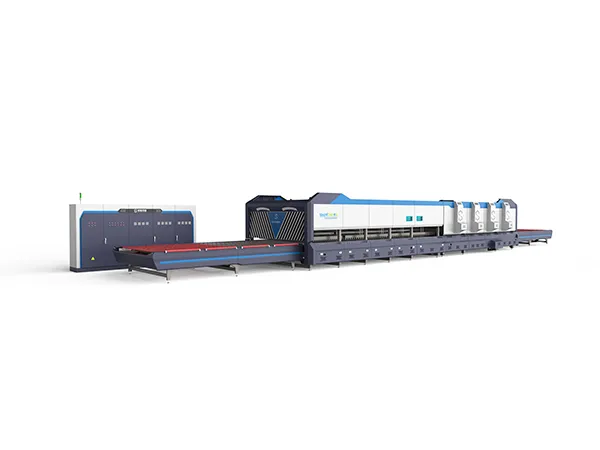The glass tempering process is a method used to strengthen glass, making it much more resistant to impact, thermal stress, and breakage. The process involves heating the glass to a high temperature and then rapidly cooling it to create internal stress, which increases the glass's strength.
Steps in the Glass Tempering Process

Cutting and Shaping
The glass is first cut and shaped to the desired dimensions. It’s important that all edges are smooth because sharp edges can result in weaknesses during the tempering process.
Heating
The glass is heated to a temperature between 600°C (1112°F) and 650°C (1202°F). At this stage, the glass becomes soft and malleable, but it doesn’t melt.
Quenching (Rapid Cooling)
After the glass reaches the desired temperature, it is quickly cooled using high-pressure air jets. The cooling happens very quickly, typically within 1 to 2 minutes.
Outer Surface Cooling: The outer surfaces of the glass cool down rapidly, solidifying quickly.
Inner Core: The inner part of the glass cools more slowly, creating a compression layer on the outer surface and tension inside the glass.
Strengthening
This combination of compressed outer layers and tension inside gives tempered glass its characteristic strength. The compressive stress makes the glass much more resistant to cracks and breakage.
Edge Inspection and Quality Control
After tempering, the glass is checked for quality. If the glass has any defects, it may need to be discarded or reprocessed. Additionally, tempered glass cannot be cut or altered after tempering without compromising its strength, so this inspection step is important before final installation.
Characteristics of Tempered Glass

Strength: Tempered glass is approximately 4 to 5 times stronger than regular, annealed glass of the same thickness.
Safety: When tempered glass breaks, it fractures into small, blunt pieces instead of sharp shards, reducing the risk of injury.
Thermal Resistance: Tempered glass is more resistant to thermal stress and can withstand temperature differences up to about 200°F (93°C) without breaking.
Applications: Commonly used in applications such as car windows, shower doors, glass tables, phone screens, and architectural glass in buildings.
Types of Glass That Can Be Tempered

Float Glass: The most common type of glass that can be tempered.
Laminated Glass: Typically not tempered, though it may be used in some applications.
Borosilicate Glass and Other Specialty Glasses: Often used in lab equipment, although these may require different processing techniques.
Advantages of Tempered Glass

Improved Durability: Can withstand greater force or pressure.
Safety: When tempered glass breaks, it doesn't create sharp shards, reducing injury risk.
Resistance to Environmental Conditions: More resistant to thermal shock (temperature differences), making it suitable for hot or cold environments.
Aesthetics and Performance: Provides a sleek, modern look while maintaining high safety standards.
In summary, tempering glass increases its strength and safety by creating internal stresses through a process of heating and rapid cooling. It's commonly used in environments where glass is exposed to high impact or temperature changes.











